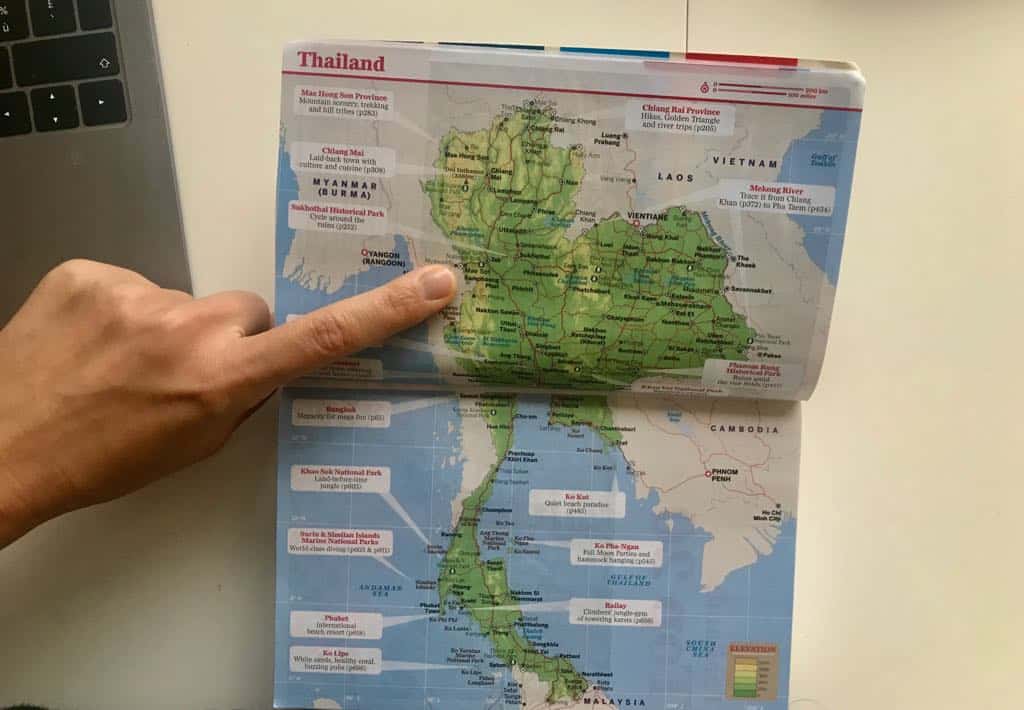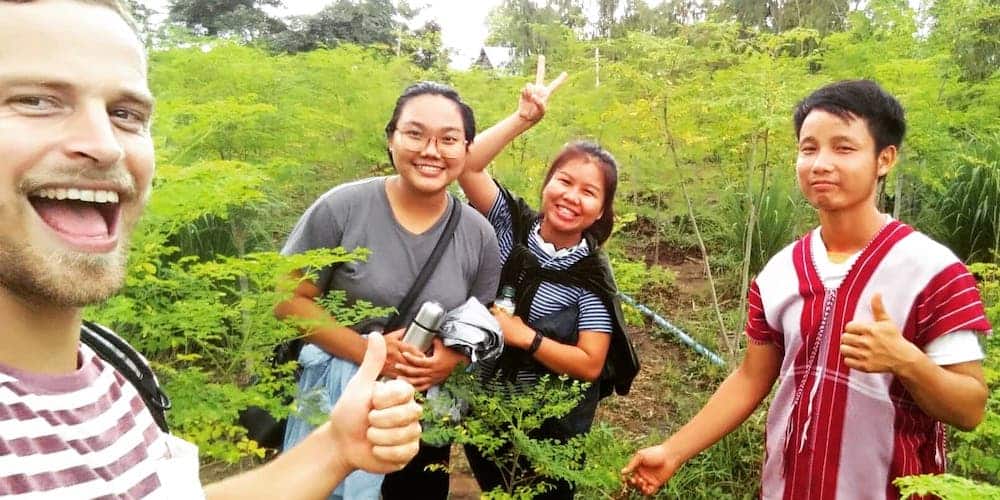MEMO ABOUT MORINGA
✓ It’s a tree from equatorial regions with extremely rapid growth
✓ It’s packed with protein, essential amino acids, vitamins, and iron
✓ It’s also a natural source of antioxidants
✓ It is anti-inflammatory, and helps regulate blood pressure and blood sugar
Mae Sot and the Karen refugees
It was while researching moringa cultivation in Thailand and Burma (Myanmar) that we came across the YouTube channel of MORINGOOD. It’s not just a brand of fresh moringa in powder and capsules, but a solidarity project born two years ago near Mae Sot, on the Thai-Myanmar border. Its founder Thibaud, a 30-year-old Swiss, tells us his story, unfiltered. In Franglais, made from 9 years of living in Thailand 🙂
“Three years ago, I was an addict. I was here in Bangkok. I used drugs, I drank, I smoked, and I was also addicted to sex. That’s it. At the time I was making documentaries, and I was allowed to go to Mae Sot, on the border with Burma, to work on human rights.”

Mae Sot is one of the main gateways to Burma. It’s also a place where many members of the Karen ethnic group take refuge, persecuted by the Burmese army. The Karen have been in conflict with the Burmese military junta since 1948, and today they are facing expropriations.
Thibaud settles in Mae Sot and builds relationships with Karen people, especially teachers. They take him to church (the Karen are Buddhist and Christian).
“I began to pray to Jesus. I tried to be useful, to understand how one can be fulfilled in life. To reach this level of satisfaction, which cannot be satisfied by material things, I realized that I had to put myself at the service of others.”
The divine vision: More in Good
He then radically changed his lifestyle and returned to Switzerland for a while.
“My brother had inflammatory problems in his shoulders, and after doing some research he bought moringa at an organic store and started taking it. After two weeks it was gone, even though he’d been dealing with it for years! But it didn’t really register with me at the time, because I don’t have health problems.”
You might expect him to tell us how his brother ultimately convinced him of moringa’s exceptional properties. But the intermediary is more surprising…

“I was working on a feature film. At the time I was praying a lot to Jesus. I was on the set decoration team; I was painting a white wall, or sanding it down, a somewhat boring job. And BAM I received the vision of Moringood. Everything was there. The name, the business model. It was extremely clear: I had to go back to Mae Sot, to the border, and set up a project with the Karens. And we were going to start planting thousands of trees.”
A charity business supported by the diaspora
And guess what, that’s what happened! Thibaud went back to Mae Sot and shared his idea with his Karen friends. And 8 months later, in collaboration with the local communities, 5,000 trees had been planted on both sides of the border (separated at that point by a river that can be easily crossed).
“The Karen people, whether they are refugees in Thailand or return to the Burmese side after years of exile, live in extremely precarious conditions. They try to survive by planting corn and beans, and for that they go into debt, use fertilizers and pesticides for higher yields, and the land ends up completely polluted and can no longer produce.”
Moringood offers them an alternative: cultivating a tree with extremely rapid growth and recognized nutritional properties. Moringa is therefore interesting in two ways for them: when integrated into the diet, it helps address certain deficiencies. And its cultivation quickly becomes profitable.

Thibaud assures us, his moringa is 100% organic, free of pesticides and synthetic fertilizers, which is no small feat in these regions where Monsanto rules.
Moringood is above all a charity business. That is to say, a company whose goal is both to make money and to have a positive social and environmental impact. Part of the profits from the sale of moringa powder is returned to the local schools partnering in the project. Thibaud questions the sustainability of the NGOs operating in Mae Sot.
“If I could do only philanthropy, I would. It’s a beautiful thing. But if, like all the NGOs in Mae Sot, you rely solely on donations, one day it can stop. And then what do you do? I like this adage: give a man a fish and he will eat for a day; teach him to fish and he will eat forever.”
This is how the teachers at the schools partnering with Moringood also involve their students in the project, and teach them what moringa is, its health benefits, and how to harvest it.

There are about 5 million Karen people worldwide. The diaspora is mainly present in Australia, Canada and Sweden. The ethnic group shows great solidarity toward refugees.
“Our clientele is mainly Karen people around the world! 80% of our customers are Karen. The rest are tourists who come to visit our shop in Mae Sot.”
The benefits of moringa for people and the earth
Thibaud reminds us with boundless enthusiasm why moringa is good for us and for the earth. By the way, what does this so-called “miracle” tree look like and how is it cultivated?
A very generous tree
“So it’s a tree that grows in the equatorial belt, on all continents. And it grows very fast! It’s made up of 75% water. If you’re in the forest and you’re thirsty, you break a branch and drink !”
Good to know.
“It’s a very generous tree. Everything is edible! It has long pods that are eaten in soup, and from which you can harvest the seeds once dried. It produces a huge number of seeds and leaves, packed with nutrients. You can also eat the flowers, make tea from the leaves, extract oil, and make toothpaste from the ashes of the small branches.”

Earth-friendly production and a quick harvest
“We harvest these seeds, plant them before the rainy season, and four months later they grow; you can already harvest the leaves! It still depends on whether there’s sun during the rainy season. Then when it’s the dry season, with the sun, it grows even more! We don’t use synthetic fertilizers or pesticides.”
“On Indian and Chinese markets for industrial moringa, not only are the leaves dried at high temperatures and therefore have far fewer benefits, but traces of heavy metals and pesticides !”
For their part, Thibaud and his Karen friends respect the land and don’t have large-scale production. Their trees are healthy, their stock is very limited, ensuring great freshness of the product.
Washing and drying the leaves

Moringood has just moved into a new factory, more spacious than the previous one, where the leaves are prepared. First they are soaked in clean water, then in salt water to kill microbes. They are rinsed again and dried on nets in the shade to preserve the chlorophyll from the sun.
They are dried using a low-temperature dehumidifier to preserve all their benefits. Then they are compressed in a machine to obtain the powder. This is poured into small moisture-proof sachets that allow moringa to be preserved for two years. Moringood also packages it in cellulose capsules.
Benefits for your whole body

“Moringa will boost your energy, nourish your brain… It’s full of omega-3! And you feel much more positive. It rebalances your carbs, your cholesterol level. I don’t understand why everyone doesn’t take it, it’s the dietary supplement that everyone needs.”
According to Thibaud, today, even if we have a varied diet, our plant foods are depleted in nutrients compared with 50 years ago. We are advised to compensate for these losses with dietary supplements or superfoods. It can be turmeric with pepper, maca, spirulina…
“For me, moringa is the most powerful because it truly contains all the nutrients the body needs. And a huge amount of antioxidants. You can do six-month cures, then take a break of two to three months. About 5 g per day is recommended for people in good health. And more for people who have diabetes or blood pressure that is too high.”
And what about the taste?
When we open the pouch that Thibaud brought us directly from the plantation, it immediately makes us think of matcha ! The powder smells good, it’s super fresh. In taste, it’s slightly bitter, reminding us of green vegetables and nuts.
Our Swiss friend recommends mixing it into a smoothie or a fruit salad, or making an infusion in the morning: hot water, lemon, moringa, a great boost!
He also shares his favorite recipe: mix one tablespoon of moringa with three eggs, Parmesan, salt, pepper, and voilà — a delicious moringa omelette!
What’s next?
Currently, Moringood manages to produce 40 kg of powder per month. Orders are becoming more and more frequent.
The idea for the future is to develop the same type of project in other regions affected by poverty where it is possible to grow Moringa. On that note, the team is currently in discussions with a Christian community in the Philippines and another in Laos.
“During my vision, Moringood was worldwide !”

To learn more about moringa and its benefits, discover our in-depth feature here!
Enthusiastic and passionate, Thibaud puts the social and benevolent dimension at the center of his moringa cultivation. A last-minute setback prevented us from visiting Moringood’s plantations in Mae Sot, but we hope to see this beautiful project take shape and grow as it should soon 🙂



